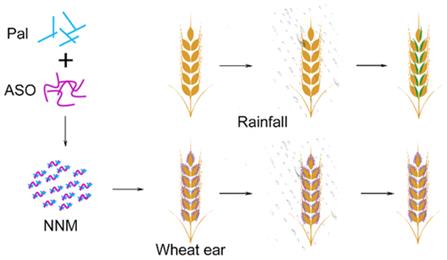科研人员研发出小麦穗发芽防控新技术

近期,中国科学院合肥物质科学研究院技术生物与农业工程研究所研究员吴丽芳课题组在小麦穗发芽防控技术研究方面取得新进展,研究人员利用经过修饰的天然纳米材料为主要原料制备出一种抗小麦穗发芽防护剂,可替代化学农药防控穗发芽。这一成果对提高小麦品质和减少化学农药的环境释放具有重要意义。
小麦穗发芽作为世界性的农业问题,不仅影响产量,而且严重降低小麦的加工品质和种用价值,从而带来严重的经济损失。培育穗发芽抗性品种,适期播种和收获以及化学防控是防控穗发芽的常规做法。化学防控虽然可在一定程度上抑制穗发芽,但具有成本高、稳定性差、易造成污染和预防的盲目性大等缺点。随着人们对美好生活和粮食品质需求的增长,低成本、无毒、高效的抑制穗发芽技术具有很大市场需求。
研究所的该课题组通过对天然纳米材料凹凸棒土进行修饰,制备出一种疏水纳米材料,该材料可在小麦籽粒表面形成致密疏水结构,显着抑制小麦种子的呼吸作用以及对水分的吸收。该技术具有施用简便、环境友好等优势,具有很好的应用前景。相关成果已被美国化学会期刊ACS Sustainable Chemistry & Engineering 接收发表。
该研究工作获得中科院STS十三五重大突破项目、安徽省重大专项和合肥研究院“十三五”规划项目的支持。(来源:中国科学院合肥物质科学研究院)
Controlling Preharvest Sprouting of Wheat through Nanonetworks
Abstract To address the severe problem of preharvest sprouting of wheat, we fabricated and tested a nanonetwork-structured nanocomposite using palygorskite modified by amino silicon oil. The nanocomposite was used as a nanonet membrane (NNM) on the surface of wheat seeds to effectively inhibit preharvest sprouting (PHS). The NNM made the surface of the wheat seeds rougher and formed a hydrophobic nanomembrane on the surface of the wheat ears, effectively preventing the wheat seeds from adsorbing water. The PHS ratio of wheat decreased by 51.4% in the experimental group compared to the control. This study provides a promising approach to prevent wheat preharvest sprouting, which has potential value for application to wheat production.
原文链接:https://pubs.acs.org/doi/pdfplus/10.1021/acssuschemeng.8b02528

